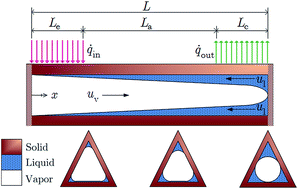Thermal analysis of Al2O3/water nanofluid-filled micro heat pipes
Abstract
Micro heat pipe is an effective micro-scale cooling device and its operation is sustained by two-phase heat transfer and capillary suction. Based on the first-principles calculation to yield the heat and fluid flow characteristics, this work delineates the thermal performance of micro heat pipes utilizing a nanofluid as a working fluid. Heat transport capacity and thermal resistance are compared as the performance indicator of nanofluids at different nanoparticle concentration fractions in an optimally charged micro heat pipe. The performance of a nanofluid-filled micro heat pipe is deemed to decline if we use heat transport capacity as a performance indicator, which is contrary to the indication of thermal resistance. We elucidate the factors contributing to the contradictory results in the thermal performance of a nanofluid-filled micro heat pipe using different performance indicators to explain the underlying physical significance of the use of a nanofluid on the performance of micro heat pipes.


 Please wait while we load your content...
Please wait while we load your content...